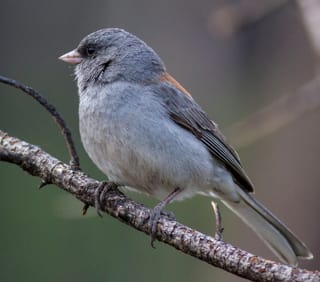Initially this guide displays common birds of all types that are flying right now in our area. Use the selectors below to view rare birds, view birds flying any time, restrict the output to a certain shape of bird, or search by name.
New Mexico is on the western edge of the Central Flyway which is one of the major migration pathways between north and south for birds traveling between breeding and wintering grounds along the Rocky Mountains. This has resulted in the state having an incredible diversity of birds with over 550 different species reported. A little more than half of this number are sighted annually on the Pajarito Plateau. Some of these birds are full-time residents, some migrate here for a few weeks or months, and other are only seen briefly as they pass through the region.
This guide features many of the birds known to frequent Los Alamos county by when they are likely to be seen in the area. You can get additional information on local birds by joining PEEC Birders or going to the eBird website. eBird also includes lists of rare bird sightings and birding hot spots.
Bird References
Birdweb
Cornell Lab of Ornithology
eBird
eNature
Institute for Bird Populations
National Audubon Society
New Mexico Ornithology Society
What Bird
xeno-canto
Subject Area Experts (all guides)
Steve Cary (butterflies)
Beth Cortright (insects)
Terry Foxx (invasive plants)
Leslie Hansen (mammals)
Richard Hansen (fish, mammals)
Dorothy Hoard (butterflies, trees)
Chick Keller (flowers, herbarium)
Shari Kelley (geology)
Kirt Kempter (geology)
Garth Tietjen (reptiles)
David Yeamans (birds)
Web Development and Content Management
Pat Bacha
Jennifer Macke
Graham Mark
Akkana Peck
Contact
Please contact us for local nature questions and sightings. We welcome comments, corrections, and additions to our guides.
For more information about local nature, please visit our Nature Blog or subscribe to PEEC This Week.
Make Selection
 Photo: Oregon variant by Jonathan Creel  Photo: grey-headed variant by Mouser Williams  Photo: pink-sided variant by Mouser Williams |  Dark-eyed JuncoDEJU (Junco hyemalis)Family: Emberizidae (New World Sparrows and Allies) Size: 5 - 6.3 in (13 - 16 cm) Flies: Jan 01 - Dec 31 Morphology: both sexes are generally dark gray or brown with a pink bill and white outer tail feathers; there is a large range of geographical variation in color with the Oregon, white-winged, pink-sided, and grey-headed variations found in the local area Status: native; common Food source: mostly feeds on seeds and grasses with occasional small fruits and insects; young primarily fed insects Habitat: open forests, mixed woods, fields, parks, gardens Dark-Eye Juncos are lively territorial birds that are commonly called “snowbirds” because they are a herald of winter. They are often seen feeding on snow-covered berry bushes and grasses. They travel in flocks with one leader. Dark-eyed Juncos mostly forage on the ground, often under a feeding tray. They particularly enjoy gardens that have gone to seed with water nearby. Open cup-shaped nests are usually found on the ground hidden under things like overhanging grass or exposed roots. These birds may have multiple broods per year with incubation time being about 2 weeks. The young usually leave the nest about 2 weeks after hatching. Info Photos Distribution Frequency Featured |
